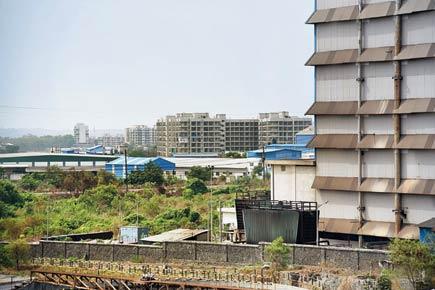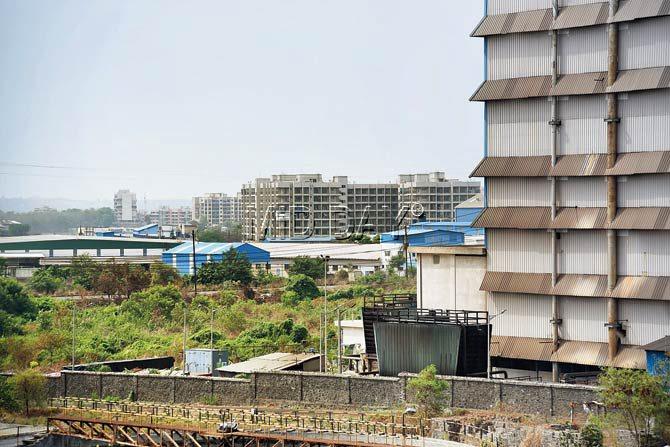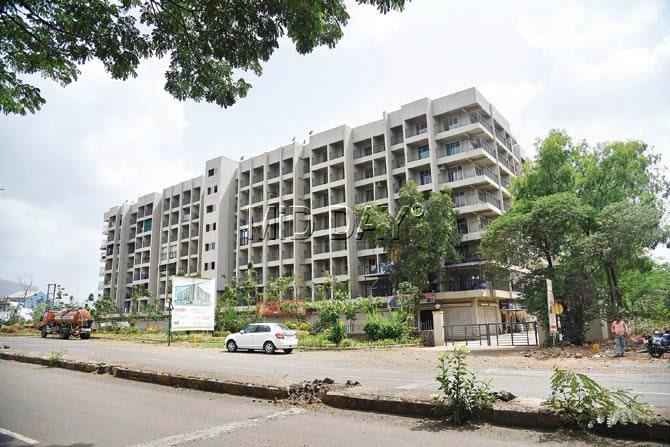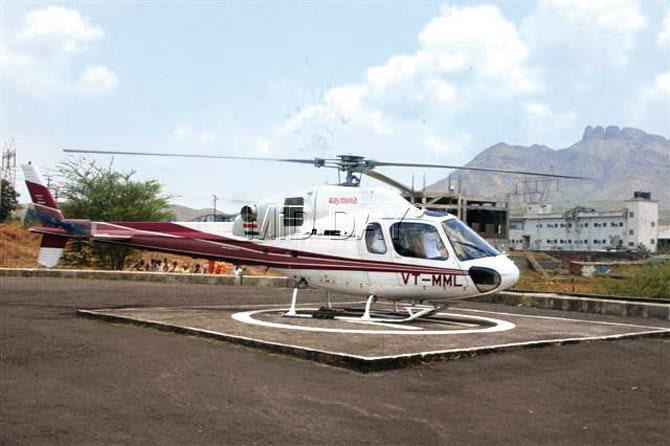The 300-home residential complex in Ambernath MIDC is surrounded by deadly industrial units on all sides; factory owners say their concerns were ignored while granting permission

Days after this paper exposed how toxic waste accumulated over 10 years is threatening the very existence of the Ambernath MIDC, it has emerged that an operational helipad bang in the middle of the industrial area has been turned into a residential complex of 300 homes.
ADVERTISEMENT

The homes (seen in the background), spread across six towers of seven floors each, are now ready and buyers have started moving in, unmindful of the hazards they face. Pics/Sameer Markande
The land use for the helipad at the Additional MIDC in Ambernath was quietly changed from industrial to residential in 2012, despite opposition from top officials and industrial unit owners. The homes, spread across six towers of seven floors each, are now ready and buyers have started moving in, unmindful of the hazards they face. Only on May 26, 2016, 11 people were killed in an explosion at the nearby Dombivili MIDC.

The Patel Bliss complex shares a wall with engineering units that have inflammable acetylene cylinders
While industrial safety norms mandate a 100-metre buffer between residential buildings and factories, the complex — called Patel Bliss – shares its compound wall with engineering units that house highly inflammable acetylene cylinders.

The land use for the helipad at the Additional MIDC in Ambernath was quietly changed from industrial to residential in 2012, despite opposition from top officials and industrial unit owners
The 1,200-acre Ambernath Additional MIDC was formed in 1995 to streamline the functioning of garment and tannery industries from the Dharavi, Mumbai, Thane and Ulhasnagar areas. But with the tanneries refusing to move and very few garment units agreeing, MIDC in 2002 allotted the area to other industries like chemical, engineering, pharmaceuticals and textile. By 2008, it had swelled to 900 units.
Charansingh Nikhar, a chemical expert who is a senior safety official of the Mutual Aid Response Group (MARG) formed by the Additional MIDC, said these chemical units house a lot of dangerous and inflammable material. He said till date, there have been 10 to 12 major fires. Two years ago, a reactor blast in a chemical unit manufacturing liquid bromine, bromide, bromo-acetic acid and hydro-bromic acid, etc, brought operations to a standstill and affected hundreds. Two workers were killed in a similar incident in 2008.
“Some units use the highly explosive ethylene oxide and others have liquefied isobutylene, which can catch fire by merely coming in contact with air,” said Nikhar. “Then there are poisonous gases like ammonia, chloride and bromine used in pharmaceuticals units. The Dombivili reactor that exploded on May 26 had a capacity of 1,500 litres. Here, we have chemical tanks with capacities over 1 lakh litres.”
Umesh Tayade, Chairman of the Additional Ambernath Manufactur-ers Association (AAMA), said the nearest hospital is 10 kilometres away and that the fire station has only two fire engines.
Atul Mangalkar, Fire Officer, Additional MIDC Fire Station, said, “Allowing a residential building within MIDC is a policy decision and since we now have the building inside, we are more concerned about LPG cylinders being used in homes, which can come into contact with toxic fumes and create a challenging situation.”
Helipad disappears
It is for safety concerns like these that the AAMA objected to the removal the helipad. Further, the pad was of great use for them, with CEOs and high-ranking employees of clients from both India and abroad could take a chopper from Mumbai. Senior defence officials also used the helipad to visit the Naval Materials Research Laboratory (NMRL) and the DRDO defence laboratory situated here.
“In 2012, we were shocked to learn that the 5-acre helipad was closed and land usage was changed in the MIDC’s Development Plan from helipad to residential. Now, this tower is ready and people are moving in. On the other hand, our request for additional allotment of industrial plots has not been accepted till date.”
When the AAMA wrote in protest to the MIDC, it was told the land was lying unused and will be better utilised for homes of senior managers working in the industrial units. “We realised it was a well-planned strategy by politicians and bureaucrats from the state-run industry department,” said Tayade.
AAMA said if the MIDC was so keen in building a residential tower for unit employees, it should have assigned AAMA the job.
“Allowing a private builder to construct and sell homes to outsiders exposes their designs. MIDC has a similar residential zone (even that is outside the core industrial area) near Ambernath station on the B-Cabin Road, which is lying unused and is encroached upon,” said AAMA Vice President Makarand Pawar.
The AAMA office bearers even approached the then CEO of MIDC, Dr Kshatrapati Shivaji, who agreed with them and categorically objected to converting the helipad into a residential tower.
Shivaji, who is now Chairman & Managing Director of the Small Industries Development Bank of India, told mid-day that he would often state his reservations in writing, as he believed ad hoc change of land usage should only happen if it is in the larger interest of the state and not otherwise.
“I do not exactly remember the particulars,” Shivaji told mid-day. “But I firmly believed such action should be undertaken only in the best interest of the sate for boosting and accelerating industrial growth.”
State Industry Minister Subhash Desai’s office told mid-day he was traveling and will not be able to comment for this report. His junior, the state minister for industries, Pravin Pote Patil, said he was in Amravati and does not know about the issue. Sanjay Sethi, CEO, MIDC, said he will have to check the records on conversion of land use and hence will not be able to comment.
Joint CEO, MIDC, Abhasaheb Jarhad, said, “MIDC, being a planning authority, has the power to change land usage. But since this decision was taken few years ago, I will have to go through our records as to why it was decided to change a helipad to residential.”
 Subscribe today by clicking the link and stay updated with the latest news!" Click here!
Subscribe today by clicking the link and stay updated with the latest news!" Click here!







